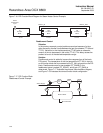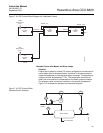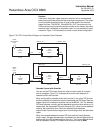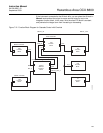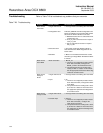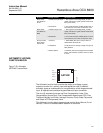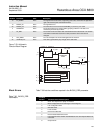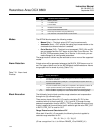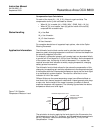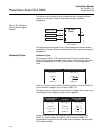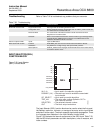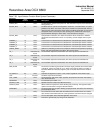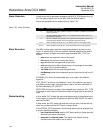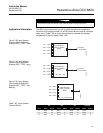
Instruction Manual
IM-106-880C, OI
September 2009
Hazardous Area OCX 8800
7-54
Modes The ARTHM block supports the following modes:
• Manual (Man) – The block output (OUT) may be set manually.
• Automatic (Auto) – OUT reflects the analog input measurement or the
simulated value when simulation is enabled.
• Out of Service (O/S) – The block is not processed. FIELD_VAL and PV
are not updated and the OUT status is set to Bad: Out of Service. The
BLOCK_ERR parameter shows Out of Service. In this mode, you can
make changes to all configurable parameters.
The target mode of a block may be restricted to one or more of the supported
modes.
Alarm Detection A block alarm will be generated whenever the BLOCK_ERR has an error bit
set. The types of block error for the ARTHM block are defined above. Alarms
are grouped into five levels of priority (Table 7-31).
Table 7-31. Alarm Level
Priorities
Block Execution The Arithmetic function block provides range extension and compensation
through nine (9) arithmetic types.
There are two inputs (IN and IN_LO) used in calculating PV. PV is then
combined with up to three inputs (IN_1, IN_2, and IN_3) through the user
selected compensation function (ARITH_TYPE) to calculate the value of func.
A gain is applied to func and then a bias is added to get the value PRE_OUT.
In AUTO, PRE_OUT is used for OUT.
Range Extension and Calculation of PV
When both IN and IN_LO are usable, the following formula is applied to
calculate range extension for PV:
PV = G * IN + (1 - G) * IN_LO
(G has a range from 0 to 1, for IN from RANGE_LO to RANGE_HI.)
9 Memory Failure
10 Lost Static Data
11 Lost NV Data
12 Readback Check Failed
13 Device Needs Maintenance Now
14 Power Up: The device was just powered-up.
15 Out of Service: The actual mode is out of service.
Condition
Number
Condition Name and Description
Priority
Number
Priority Description
0 The priority of an alarm condition changes to 0 after the condition that caused
the alarm is corrected.
1 An alarm condition with a priority of 1 is recognized by the system, but is not
reported to the operator
2 An alarm condition with a priority of 2 is reported to the operator, but does not
require operator attention (such as diagnostics and system alerts).
3-7 Alarm conditions of priority 3 to 7 are advisory alarms of increasing priority.
8-15 Alarm conditions of priority 8 to 15 are critical alarms of increasing priority.



